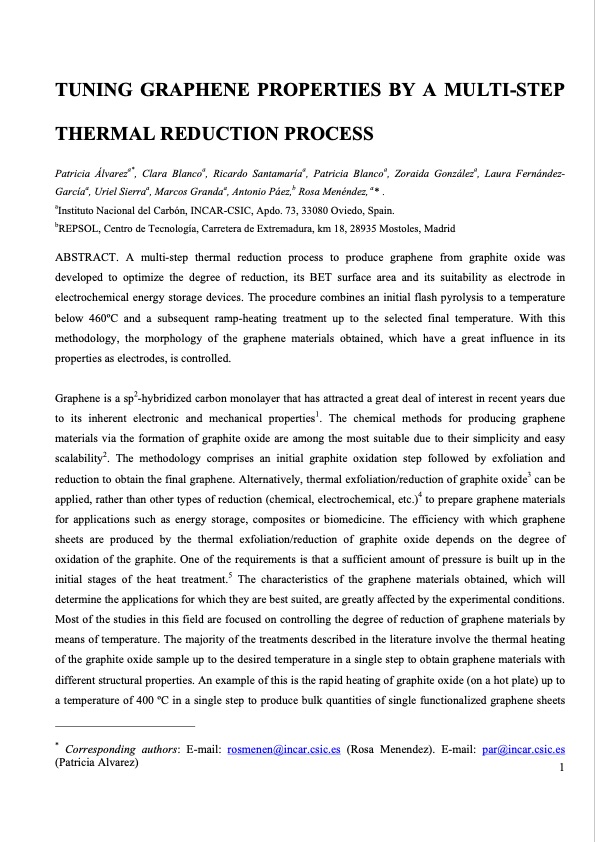
PDF Publication Title:
Text from PDF Page: 001
TUNING GRAPHENE PROPERTIES BY A MULTI-STEP THERMAL REDUCTION PROCESS Patricia Álvareza*, Clara Blancoa, Ricardo Santamaríaa, Patricia Blancoa, Zoraida Gonzáleza, Laura Fernández- Garcíaa, Uriel Sierraa, Marcos Grandaa, Antonio Páez,b Rosa Menéndez, a*1. aInstituto Nacional del Carbón, INCAR-CSIC, Apdo. 73, 33080 Oviedo, Spain. bREPSOL, Centro de Tecnología, Carretera de Extremadura, km 18, 28935 Mostoles, Madrid ABSTRACT. A multi-step thermal reduction process to produce graphene from graphite oxide was developed to optimize the degree of reduction, its BET surface area and its suitability as electrode in electrochemical energy storage devices. The procedure combines an initial flash pyrolysis to a temperature below 460oC and a subsequent ramp-heating treatment up to the selected final temperature. With this methodology, the morphology of the graphene materials obtained, which have a great influence in its properties as electrodes, is controlled. Graphene is a sp2-hybridized carbon monolayer that has attracted a great deal of interest in recent years due to its inherent electronic and mechanical properties1. The chemical methods for producing graphene materials via the formation of graphite oxide are among the most suitable due to their simplicity and easy scalability2. The methodology comprises an initial graphite oxidation step followed by exfoliation and reduction to obtain the final graphene. Alternatively, thermal exfoliation/reduction of graphite oxide3 can be applied, rather than other types of reduction (chemical, electrochemical, etc.)4 to prepare graphene materials for applications such as energy storage, composites or biomedicine. The efficiency with which graphene sheets are produced by the thermal exfoliation/reduction of graphite oxide depends on the degree of oxidation of the graphite. One of the requirements is that a sufficient amount of pressure is built up in the initial stages of the heat treatment.5 The characteristics of the graphene materials obtained, which will determine the applications for which they are best suited, are greatly affected by the experimental conditions. Most of the studies in this field are focused on controlling the degree of reduction of graphene materials by means of temperature. The majority of the treatments described in the literature involve the thermal heating of the graphite oxide sample up to the desired temperature in a single step to obtain graphene materials with different structural properties. An example of this is the rapid heating of graphite oxide (on a hot plate) up to a temperature of 400 oC in a single step to produce bulk quantities of single functionalized graphene sheets * Corresponding authors: E-mail: rosmenen@incar.csic.es (Rosa Menendez). E-mail: par@incar.csic.es (Patricia Alvarez) 1PDF Image | TUNING GRAPHENE MULTI-STEP THERMAL REDUCTION PROCESS

PDF Search Title:
TUNING GRAPHENE MULTI-STEP THERMAL REDUCTION PROCESSOriginal File Name Searched:
36194253.pdfDIY PDF Search: Google It | Yahoo | Bing
Salgenx Redox Flow Battery Technology: Power up your energy storage game with Salgenx Salt Water Battery. With its advanced technology, the flow battery provides reliable, scalable, and sustainable energy storage for utility-scale projects. Upgrade to a Salgenx flow battery today and take control of your energy future.
| CONTACT TEL: 608-238-6001 Email: greg@infinityturbine.com | RSS | AMP |